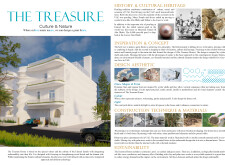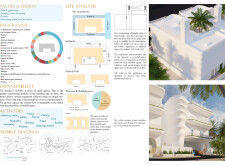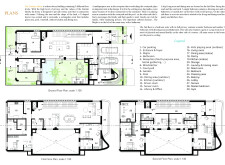5 key facts about this project
### Project Overview
Located in the United Arab Emirates, the architectural design incorporates elements of cultural heritage and environmental sustainability within a three-storey structure. The project emphasizes community, family life, and a connection to nature, grounded in Emirati cultural values while accommodating contemporary requirements for adaptability and ecological responsibility.
### Spatial and Cultural Strategy
The design draws inspiration from the traditions of pearl diving, a significant aspect of Emirati history. It aims to create a connection between architecture, social interaction, and the natural environment. The incorporation of organic forms, reminiscent of oyster shells, facilitates multifunctional spaces that prioritize family gatherings. Features such as *mashrabiyas* and courtyards are integrated to enhance social connectivity while ensuring privacy for residents. Ample green areas, including gardens and outdoor spaces, reinforce the relationship between living spaces and the surrounding landscape.
### Material and Sustainability Integration
The project employs a careful selection of materials designed for both aesthetic appeal and practical functionality. 3D-printed concrete forms the primary structural elements, allowing for intricate design while optimizing construction efficiency. Palm trees are utilized not only for structural support but also contribute to the visual character. Additionally, fiberglass reinforced plastic is used in the façades for durability, and polycarbonate panels provide natural light in divisions such as the staircase.
Sustainability is a core consideration, exemplified by features such as rainwater catchment systems and cross-ventilation strategies that reduce reliance on mechanical climate control. Natural daylighting is maximized throughout the building to lower energy consumption. Recyclable materials like clay and palm components solidify the environmental commitment of the design, while windcatchers are incorporated for traditional ventilation, blending historical practices with contemporary aesthetics.






















































